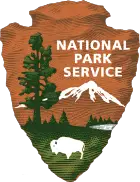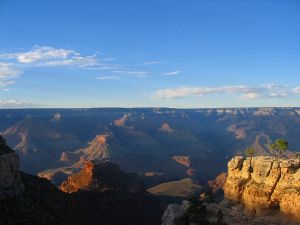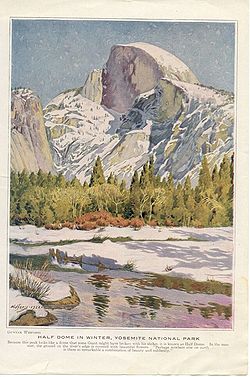National Park Service
| National Park Service | |
 National Park Service Arrowhead | |
| Agency overview | |
|---|---|
| Formed | August 25, 1916 |
| Headquarters | Main Interior Building (MIB), Washington, D.C. |
| Employees | 15,000 permanent, 5,000 seasonal |
| Annual Budget | $2.256 billion (2006) |
| Agency Executive | Mary A. Bomar, Director |
| Parent agency | Department of the Interior |
| Website | |
| www.nps.gov | |
The National Park Service (NPS) is the United States federal agency that manages all National Parks, many National Monuments, and other conservation and historical properties with various title designations.[1] It was created on August 25, 1916, by Congress through the National Park Service Organic Act.[2]
It is an agency of the United States Department of the Interior, which is a Cabinet Office of the executive branch, overseen by a Secretary nominated by the President and confirmed by the Senate. Most of the direct management of the NPS is delegated by the Secretary to the National Park Service Director, who must now also be confirmed by the Senate.
The NPS oversees over 391 units, of which 58 are designated national parks.
History
National Parks establishment
The national park idea has been credited to the artist George Catlin. In 1832 he traveled the northern Great Plains of the United States, where he became concerned about the destruction of the Native American civilization, wildlife, and wilderness as eastern settlements spread westward. He wrote, “by some great protecting policy of government . . . in a magnificent park. . . . a nation’s park, containing man and beast, in all the wild[ness] and freshness of their nature’s beauty!” [3]
Catlin’s vision had no immediate effect. In the east, romantic portrayals of nature by James Fenimore Cooper and Henry David Thoreau and painters Thomas Cole and Frederick Edwin Church began to compete with the prevailing view of wilderness as a challenge to be overcome. Slowly unspoiled nature and spectacular natural areas of the West became better known and the idea of saving such places gained interest.
Yellowstone National Park was the first national park to be designated in the world, in 1872. There was no state government to manage it, so the federal government assumed direct control. Yosemite National Park began as a state park; the land for the park was donated by the federal government to the State of California in 1864 for perpetual conservation. Yosemite was later returned to federal ownership.
Establishment and Growth of the National Park System, 1916 - 1933
Forty-four years after the establishment of Yellowstone, when President Woodrow Wilson created the National Park Service on August 25, 1916. For years J. Horace McFarland, President of the American Civic Association; Secretaries of the Interior Walter Fisher and Franklin K. Lane; Presidents William Howard Taft and Woodrow Wilson; Frederick Law Olmsted, Jr.; Representatives William Kent and John E. Raker of California; Senator Reed Smoot of Utah; Stephen T. Mather and Horace M. Albright had been seeking the creation of separate agency to manage the National Parks and Monuments. [4]
National parks and national monuments in the United States were originally individually managed under the auspices of the Department of the Interior. The movement for an independent agency to oversee these federal lands was spearheaded by business magnate and conservationist Stephen Mather as well as J. Horace McFarland. With the help of journalist Robert Sterling Yard, Mather ran a publicity campaign for the Department of the Interior. They wrote numerous articles that praised the scenic qualities of the parks and their possibilities for educational, inspirational and recreational benefits.[5] This campaign resulted in the creation of a National Park Service. On August 25, 1916, President Woodrow Wilson signed a bill that mandated the agency "to conserve the scenery and the natural and historic objects and wildlife therein, and to provide for the enjoyment of the same in such manner and by such means as will leave them unimpaired for the enjoyment of future generations."[6] Mather became the first director of the newly formed NPS.[7]
Since its inception in 1916, the National Park Service manages each of the United States' National Parks, which have grown in number over the years to 58.
At first, each national park was managed independently, with varying degrees of success. In Yellowstone, the civilian staff was replaced by the U.S. Army in 1886. Due to the irregularities in managing these national treasures, Stephen Tyng Mather petitioned the federal government to improve the situation. In response, Secretary of the Interior Franklin K. Lane challenged him to lobby for creating a new agency, the National Park Service, to manage all national parks and some national monuments. Mather was successful with the ratification of the National Park Service Organic Act[8] in 1916. Later, the agency was given authority over other protected areas, many with varying designations as Congress created them.
Special divisions
The United States Park Police is a distinct law enforcement division of the National Park Service, with jurisdiction in all NPS sites, but primarily utilized in the Washington, D.C. metropolitan area, New York City, and Golden Gate National Recreation Area in and around San Francisco. Law enforcement services in other NPS units are provided by specially commissioned park rangers. Other special NPS divisions include the Historic American Buildings Survey, National Register of Historic Places, National Natural Landmarks, the Rivers, Trails, and Conservation Assistance Program,[9] the Challenge Cost Share Program,[10] the Federal Lands to Parks,[11] the Hydropower Relicensing Program,[12] the Land and Water Conservation Fund,[13] the National Trails System,[14] and the Partnership Wild and Scenic Rivers Program.[15]
National Park System
The National Park System is a term that describes the collection of all units managed by the National Park Service, and it is not necessary for the title or designation of the unit to include the term "park" - indeed most do not. The system encompasses approximately 84.4 million acres (338,000 km²), of which more than 4.3 million acres (17,000 km²) remain in private ownership. The largest unit is Wrangell-St. Elias National Park and Preserve, Alaska. At 13,200,000 acres (53,000 km²) it is over 16 percent of the entire system. The smallest unit in the system is Thaddeus Kosciuszko National Memorial, Pennsylvania, at 0.02 acre (80 m²).
The National Park System (NPS) includes all properties managed by the National Park Service (also, confusingly, "NPS"). The System as a whole is considered to be a national treasure of the United States, and some of the more famous national parks and monuments are sometimes referred to metaphorically as "crown jewels".[16]
In addition to "units", and other properties that the National Park Service either owns or administers, it also provides technical and financial assistance to several "affiliated areas" authorized by Congress. The largest affiliated area is New Jersey Pinelands National Reserve at 1,164,025 acres (4711 km²). The smallest is Benjamin Franklin National Memorial at less than one hundredth of an acre.
Although all units of the National Park System in the United States are the responsibility of a single agency, they are all managed under individual pieces of authorizing legislation or, in the case of national monuments created under the Antiquities Act, presidential proclamation. For example, because of provisons within their enabling legislation, Congaree National Park is almost entirely wilderness area, yet Yosemite allows unique developments such as the Badger Pass Ski Area and the O'Shaughnessy Dam within its boundaries. Death Valley National Park has an active mine legislated within its boundaries. Such irregularities would not be found in other parks unless specifically provided for by the legislation that creates it.
Many parks charge an entrance fee ranging from US$3 to $25 per week. Visitors can buy a federal interagency annual pass, known as the America the Beautiful – National Parks and Federal Recreational Lands Pass, allowing unlimited entry to federal fee areas (USDA Forest Service, National Park Service, US Fish & Wildlife Service, Bureau of Land Management, and Bureau of Reclamation) for $80 per year. This pass applies to entry fees, only. Other applicable fees such as camping, backcountry access, etc. still apply. Those U.S. citizens who are 62+ years old may purchase a version with the same privileges, for $10, and citizens with permanent disabilities may receive a free version.[17]
National Park Service holdings
| Type | Amount | |
|---|---|---|
| Buildings | 21,000 | |
| Trails | Template:Convert/LoffAonDtableSoff | |
| Roads | Template:Convert/LoffAonDtableSoff | |
Nomenclature of the National Park System
The National Park service uses 20+ different titles for the park units it manages. The best known are the National Parks and the National Monuments.
| Classification[18] | Number | Acreage |
|---|---|---|
| National Battlefield, National Battlefield Park, National Military Park, and National Battlefield Site | 24 | 61,648.16 |
| National Historical Park, National Historic Site, and International Historic Site | 118 | 200,395.23 |
| National Lakeshore | 4 | 228,857.23 |
| National Memorial | 28 | 8,531.78 |
| National Monument | 73 | 2,706,954.60 |
| National Park | 57 | 51,914,772.65 |
| National Parkway | 4 | 173,865.28 |
| National Preserve and National Reserve | 19 | 23,742,879.74 |
| National Recreation Area | 18 | 3,692,222.58 |
| National River and National Wild and Scenic River and Riverway | 15 | 738,089.17 |
| National Scenic Trail | 3 | 225,356.57 |
| National Seashore | 10 | 594,518.33 |
| Other Designations (White House, National Mall, etc) | 11 | 39,374.33 |
| Totals | 384 | 84,327,466,.01 |
National Parks include a range of superb natural and cultural wonders. The first National Park was Yellowstone National Park, 1872.
National Monuments preserve a single unique cultural or natural feature. Devils Tower National Monument was the first in 1916.
National Historic Sites protect a significant cultural resource that is not a complicated site. Examples of these types of parks include: Ford's Theatre National Historic Site and William Howard Taft National Historic Site. National Historical Parks are larger areas with a more complex subject. Appomattox Court House National Historical Park was created in 1940. George Rogers Clark National Historical Park was dedicated in 1936. Historic sites may also be protected in National Parks, Monuments, Seashores, and Lakeshores.
National Military Parks, Battlefield Park, Battlefield site, and Battlefield preserve areas associated with military history. The different designations reflect the complexity of the event and the site. Many of the sites preserve important Revolutionary War battles and Civil War Battlefields. ‘Military Parks’ are larger actions such as Chickamauga and Chattanooga National Military Park or Vicksburg National Military Park, Gettysburg National Military Park and Shiloh National Military Park, the original four from 1890. Examples of ‘Battlefield Parks’, ‘Battlefield Sites’, and ‘National Battlefields’ include: Richmond National Battlefield Park, Brices Cross Roads National Battlefield Site, and Antietam National Battlefield.

National Seashores and National Lakeshores offer both preservation of the national coast line, while supporting water based recreation. Cape Hatteras National Seashore was created in 1937. Indiana Dunes National Lakeshore and Pictured Rocks National Lakeshore were the first to be created in 1966.
National Rivers and Wild and Scenic Riverways protect free-flowing streams over their length. The riverways may not be altered with dams, channelization or other changes. Recreational pursuits are encouraged along the waterways. Ozark National Scenic Riverways was established in 1964. Many of these units are not part of the National Park System. The U.S. Forest Service, the Bureau of Land Management and other government agencies manage wild and scenic rivers.
The National Trails System preserves long distance routes across America. The system was created in 1968 and consists of two major components. National Scenic Trails are long-distance trails through some of the most scenic parts of the country. Scenic trails received official protection in 1968. The Appalachian Trail and the Continental Divide Trail are the best known of these trails. National Historic Trails commemorate the routes of major historic events. Some of the best known trails include: the Trail of Tears; Mormon Trail; and the Santa Fe Trail.
National Preserves are for the protection of certain resources. Activities like hunting and fishing and some mining are allowed. Big Cypress National Preserve and Big Thicket National Preserve were created in 1974 as the first Nat’l Preserves.
National Reserves are similar to National Preserves, but the operational authority can be placed with a local government. City of Rocks National Reserve was the first to be established in 1988.
Concessions
In an effort to increase visitation and allow for a larger audience to enjoy national park land, the National Park Service has numerous concession contracts with private businesses to bring recreation, resorts, and other compatible amenities to their parks. NPS lodging opportunities exist at places such as Wawona Hotel in Yosemite National Park and the Fort Baker Retreat and Conference Center (currently under renovation / construction, due to open in 2008) in Golden Gate National Recreation Area. "Adaptive reuses" like those at Fort Baker have raised some controversy, however, from concerns about the historical integrity of these buildings after such extensive renovations, and whether such alterations fall within the spirit and/or the letter of the preservation laws they are protected by.
At many Park Service sites a bookstore is operated by a non-profit cooperating association. The largest example is Eastern National, which runs bookstores in 30 states.
Concessionaires offer seasonal and/or year-round employment to individuals in positions such as food service, guest service, hotel and tour operations. Most concessionaires include employment information on their websites or it may be found on job websites that list seasonal job opportunities like CoolWorks.com or JobMonkey.com.
Offices
Headquarters are located in Washington, D.C., with regional offices in Anchorage, Atlanta, Lakewood, CO (Denver), Omaha, NE, Oakland, CA, Philadelphia, and Seattle.
The headquarters building of the National Park Service Southwest Regional Office is architecturally signicant and is a designated National Historic Landmark.
Centers
The National Park Service operates four archeology-related centers: Harpers Ferry Center in Harpers Ferry, West Virginia, the Midwest Archeological Center in Lincoln, Nebraska, the Southeast Archeological Center in Tallahassee, Florida, and the Western Archeological and Conservation Center in Tucson, Arizona. The Harpers Ferry Center specializes in interpretive media development and object conservation. The other three focus to various degrees on archaeological research and museum object curation and conservation.
Training centers include: Horace Albright Training Center, Grand Canyon; Stephen Mather Training Center, Harpers Ferry, West Virginia; Historic Preservation Training Center, Frederick, Maryland; and Capital Training Center, Washington, D.C.
Regulatory Impacts
- Wilderness Act of 1964
- National Wild and Scenic River of 1968
- National Environmental Policy Act of 1970
See also
- Ansel Franklin Hall: the first Chief Naturalist and first Chief Forester of the National Park Service
- Arctic National Wildlife Refuge
- Harry Yount: considered by many the progenitor of the modern national park ranger
- List of areas in the National Park System of the United States, by type of park unit, i.e., National Park, National Monument, National Historical Parks, etc.
- List of the United States National Park System official units, by state
- Forests of the United States
- Land and Water Conservation Fund
- National Park Foundation
- National Park Passport Stamps
- National Park Service Rustic, the style of architecture used in many National Park structures, also known as parkitecture.
- U.S. National Heritage Area
- U.S. National Memorial
- U.S. National Monument
- U.S. National Park Rangers
- Roadless Area Conservation Rule
- Combat Illegal Logging Act
Notes
- ↑ Designation of National Park System Units. National Park Service. Retrieved 2008-04-05.
- ↑ The National Park Service Organic Act. National Park Service. Retrieved 2008-04-05.
- ↑ The National Parks: Shaping the System; Harpers Ferry Center; U.S. Department of the Interior, Washington, D.C., 2004.
- ↑ ibid, Lee; Part 2
- ↑ Sutter, p. 102
- ↑ Sutter, p. 104
- ↑ Albright, Horace M. as told to Robert Cahn; The Birth of the National Park Service; The Founding Years, 1913-33; Howe Brothers, Salt Lake City, Utah; 1985.
- ↑ National Park Service Organic Act
- ↑ Rivers, Trails, and Conservation Assistance Program. National Park Service. Retrieved 2008-04-05.
- ↑ Challenge Cost Share Program. National Park Service. Retrieved 2008-04-05.
- ↑ Federal Lands to Parks. National Park Service. Retrieved 2008-04-05.
- ↑ Hydropower Relicensing Program. National Park Service. Retrieved 2008-04-05.
- ↑ Land and Water Conservation Fund. National Park Service. Retrieved 2008-04-05.
- ↑ National Trails System. National Park Service. Retrieved 2008-04-05.
- ↑ Partnership Wild & Scenic Rivers. National Park Service. Retrieved 2008-04-05.
- ↑ Lee, Ronald F.; Family Tree of the National Park System; Eastern National Parks, Philadelphia, Pennsylvania, 1972; pg 9-12
- ↑ https://pwrcms.nps.gov/pwr/fees_passes.htm%7C America the Beautiful – National Parks and Federal Recreational Lands Pass
- ↑ The National Parks: Index 2001-2003, Official Index of the National Park Service, Government Printing Office, Washington D.C.; 2003
ReferencesISBN links support NWE through referral fees
- Albright, Horace M., and Robert Cahn. 1985. The birth of the National Park Service: the founding years, 1913-33. Institute of the American West books, v. 2. Salt Lake City: Howe Bros. ISBN 9780935704334
- Albright, Horace M., and Marian Albright Schenck. 1999. Creating the National Park Service the missing years. Norman: University of Oklahoma Press. ISBN 9780585100746
- Dilsaver, Lary M. 1994. America's national park system: the critical documents. Lanham, Md: Rowan & Littlefield Publishers. ISBN 9780847679225
- Everhart, William C. 1972. The National Park Service. Praeger library of U.S. Government departments and agencies, no. 31. New York: Praeger Publishers.
- Foresta, Ronald A. 1984. America's national parks and their keepers. Washington, D.C.: Resources for the Future. ISBN 9780915707034
- Garrison, Lemuel A. 1983. The making of a ranger: forty years with the National Parks. Institute of the American West books, v. 1. Salt Lake City: Howe Brothers. ISBN 9780935704181
- Gartner, Robert. 1993. Exploring careers in the national parks. New York: Rosen Pub. Co. ISBN 9780585147789
- Hartzog, George B. 1988. Battling for the national parks. Mt. Kisco, N.Y.: Moyer Bell. ISBN 9780918825704
- Ise, John. 1961. Our national park policy: a critical history. Baltimore: published for Resources for the Future by Johns Hopkins Press.
- Lee, Ronald F. 1972. Family tree of the national park system; a chart with accompanying text designed to illustrate the growth of the national park system, 1872-1972. Philadelphia: Eastern National Park & Monument Association.
- Mackintosh, Barry. 1991. The national parks: shaping the system. Washington, D.C.: U.S. Dept. of the Interior.
- National parks for the 21st century: the vail agenda. 1991. [S.l.]: Nat'L Park Fndn.
- Moffet, Ben, and Vickie Carson. 1994. National Park Service almanac. [Denver, Colo.]: Natioanl Park Service.
- Rettie, Dwight Fay. 1995. Our national park system: caring for America's greatest natural and historic treasures. Urbana: University of Illinois Press. ISBN 9780252021480
- Ridenour, James M. 1994. The National parks compromised: pork barrel politics & America's treasures. Merrillville, Ind: ICS Books. ISBN 9781570340031
- Rothman, Hal. 1989. Preserving different pasts: the American national monuments. Urbana: University of Illinois Press. ISBN 9780252015489
- Runte, Alfred. 1987. National parks: the American experience. Lincoln [u.a.]: Univ. of Nebraska Press. ISBN 9780803238787
- Sellars, Richard West. 1997. Preserving nature in the national parks: a history. New Haven: Yale University Press. ISBN 9780300069310
- Shankland, Robert; Steve Mather of the National Parks; Alfred A. Knopf, New York; 1970
- Sontag, William H. 1990. National Park Service: the first 75 years : preserving our past for the future. Philadelphia?: Eastern National Park & Monument Association]. ISBN 9780915992522
- Sutter, Paul. 2002. Driven wild: how the fight against automobiles launched the modern wilderness movement. Seattle: University of Washington Press. ISBN 9780295982199
- Swain, Donald C. 1970. Wilderness defender; Horace M. Albright and conservation. Chicago: University of Chicago Press. ISBN 9780226782928
- Udall, Stewart L. 1963. The quiet crisis. New York: Holt, Rinehart and Winston.
- Wirth, Conrad Louis. 1980. Parks, politics, and the people. Norman, Okla: University of Oklahoma Press. ISBN 9780806116051
External links
All Links Retrieved November 17, 2008.
- NPS official site
- Community Assistance Available from the National Park Service
- Criteria for inclusion in the National Park System
- Designation of National Park System Units
- Gallery of all US National Parks
- National Park System Timeline
- Records of the National Park Service
- National Park Foundation, the Congressionally chartered national charitable partner of America's National Parks
| National parks of the United States | |
|---|---|
| Acadia • American Samoa • Arches • Badlands • Big Bend • Biscayne • Black Canyon of the Gunnison • Bryce Canyon • Canyonlands • Capitol Reef • Carlsbad Caverns • Channel Islands • Congaree • Crater Lake • Cuyahoga Valley • Death Valley • Denali • Dry Tortugas • Everglades • Gates of the Arctic • Glacier • Glacier Bay • Grand Canyon • Grand Teton • Great Basin • Great Sand Dunes • Great Smoky Mountains • Guadalupe Mountains • Haleakala • Hawaii Volcanoes • Hot Springs • Isle Royale • Joshua Tree • Katmai • Kenai Fjords • Kings Canyon • Kobuk Valley • Lake Clark • Lassen Volcanic • Mammoth Cave • Mesa Verde • Mount Rainier • North Cascades • Olympic • Petrified Forest • Redwood • Rocky Mountain • Saguaro • Sequoia • Shenandoah • Theodore Roosevelt • Virgin Islands • Voyageurs • Wind Cave • Wrangell-St. Elias • Yellowstone • Yosemite • Zion List by: date established, state |
| ||||||||
| National Historical Parks of the United States | |
|---|---|
| Adams • Appomattox Court House • Boston • Cane River Creole • Cedar Creek and Belle Grove • Chaco Culture • Chesapeake and Ohio Canal • Colonial • Cumberland Gap • Dayton Aviation Heritage • George Rogers Clark • Harpers Ferry • Hopewell Culture • Independence • Jean Lafitte • Kalaupapa • Kaloko-Honokohau • Keweenaw • Klondike Gold Rush • Lewis and Clark • Lowell • Lyndon B. Johnson • Marsh-Billings-Rockefeller • Minute Man • Morristown • Natchez • New Bedford Whaling • New Orleans Jazz • Nez Perce • Pecos • Pu'uhonua o Honaunau • Rosie the Riveter/World War II Home Front • Salt River Bay • San Antonio Missions • San Francisco Maritime • San Juan Island • Saratoga • Sitka • Tumacácori • Valley Forge • War in the Pacific • Women's Rights |
| |||||||||||
Template:Registered Historic Places Template:DOI agencies
| |||||||||||||||||
Credits
New World Encyclopedia writers and editors rewrote and completed the Wikipedia article in accordance with New World Encyclopedia standards. This article abides by terms of the Creative Commons CC-by-sa 3.0 License (CC-by-sa), which may be used and disseminated with proper attribution. Credit is due under the terms of this license that can reference both the New World Encyclopedia contributors and the selfless volunteer contributors of the Wikimedia Foundation. To cite this article click here for a list of acceptable citing formats.The history of earlier contributions by wikipedians is accessible to researchers here:
The history of this article since it was imported to New World Encyclopedia:
Note: Some restrictions may apply to use of individual images which are separately licensed.





